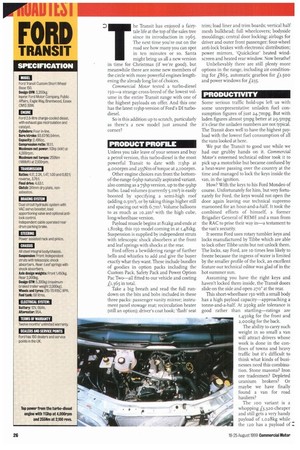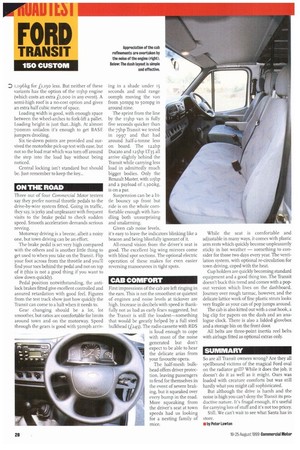FORD TRANSIT 150 CUSTOM
Page 26

Page 28

Page 30

If you've noticed an error in this article please click here to report it so we can fix it.
PRICE AS TESTED: £18,340. Includes £15,620 for basic vehicle, £1,000 for 113hp engine, £500 for Custom Option Pack, £700 for Safety Option pack, £165 for Power Pack Two, £30 for headlamp levelling and £325 for metallic paint. ENGINE: Charge-cooled 2.5-litre turbo-diesel with electronic direct injection. GAY: 3,200kg. PAYLOAD: 1,481kg. FUEL CONSUMPTION (laden): 29.48mpg (9.58/100km).
With a replacement for the ubiquitous Ford Transit just months away, what is there left to say about the current panel van bred from stock that has become a generic term for a big white van? Plenty, as the latest in a huge range of variants is a highpowered, big payload, small volume version which does the job well, is good on fuel use and has a reasonable price tag. But who in the high-street would make best use of such a spec? 0 he Transit has enjoyed a fairytale life at the top of the sales tree since its introduction in 1965. The next ti me you're out on the road see how many you can spot in ten minutes or so. Santa might bring us all a new version in time for Christmas (if we're good), but meanwhile there are some new members of the circle with more powerful engines lengthening the already long list of choices.
Commercial Motor tested a turbo-diesel 150—a strange cross-breed of the lowest volume in the entire Transit range with one of the highest payloads on offer. And this one has the latest tr3hp version of Ford's DI turbodiesel.
So is this addition up to scratch, particularly as there's a new model just around the corner?
PRODUCT PROFILE
Unless you take leave of your senses and buy a petrol version, this turbo-diesel is the most powerful Transit to date with tr3hp at 4,000rpm and 255Nm of torque at 2,100tpm.
Other engine choices run from the bottomof-the-range 69hp naturally aspirated variant, also coming as a 75hp version, up to the 99hp turbo. Load volumes (currently 5.un3) is easily boosted by specifying a semi-high roof (adding o.5m3), or by taking things higher still and spacing out with 6.7m3. Volume balloons to as much as io.2m3 with the high cube, long-wheelbase version.
Payload muscle begins at 812.1cg and ends at i,8rokg, this 150 model coming in at 1,481kg. Suspension is supplied by independent struts with telescopic shock absorbers at the front and leaf springs with shocks at the rear.
Ford offers a bewildering range of further bells and whistles to add and give the buyer exactly what they want. These include bundles of goodies in option packs including the Custom Pack, Safety Pack and Power Option Pac Two—all fitted to our vehicle and costing £1,365 in total.
Take a big breath and read the full rundown on the bits and bobs included in these three packs: passenger vanity mirror; instrument panel stowage mat; recirculation heater (still an option); driver's coat hook; 'flash' seat trim; load liner and trim boards; vertical half mesh bulkhead; full wheelcovers; bodyside mouldings; central door locking; airbags for driver and outer front passenger; four-wheel anti-lock brakes with electronic distribution; power mirrors, 'Quickclear' heated windscreen and heated rear window. Now breathe!
Unbelievably there are still plenty more options in the range, including air conditioning for 1865, automatic gearbox for 11,5oo and power windows for /235.
PRODUCTIVITY
Some serious traffic hold-ups left us with some unrepresentative unladen fuel consumption figures of just 24.7mpg. But with laden figures almost 5mpg better at 29.5mpg it's clear the unladen numbers are not typical. The Transit does well to have the highest payload with the lowest fuel consumption of all the vans looked at here.
We put the Transit to good use while we had our grubby hands on it. Commercial Motor's esteemed technical editor took it to pick up a motorbike but became confused by a heat-wave passing over the country at the time and managed to lock the keys inside the van, in the ignition.
How? With the keys to his Ford Mondeo of course. Unfortunately for him, but very fortunately for Ford, the keys would not open the door again leaving our technical supremo marooned for an hour-and-a-half. It took the combined efforts of himself, a former Brigadier General of REM E and a man from the RAC to prise their way in—a testament to the van's security.
It seems Ford uses rotary tumbler keys and locks manufactured by Tibbe which are able to lock other Tibbe units but not unlock them. The locks, say Ford, are io times less likely to freeze because the ingress of water is limited by the smaller profile of the lock, an excellent feature our technical editor was glad of in the hot summer sun.
Assuming you have the right keys and haven't locked them inside, the Transit doors slide on the side and open 270* at the rear.
This short-wheelbase 15o with a small body has a high payload capacity—approaching a tonne-and-a-half. At 25 okg axle tolerance is good rather than startling—ratings are 1,450kg for the front and 2,000kg for the back.
The ability to carry such weight in so small a van will attract drivers whose work is done in the confines of towns and heavy traffic but it's difficult to think what kinds of businesses need this combination. Stone masons? Iron ore tradesmen? Depleted uranium brokers? Or maybe we have finally found a van for road hauliers?
The too variant is a whopping £3,320 cheaper and still gets a very handy payload of 1,02,8kg while the i2o has a payload of
150 CUSTOM
D 1,19 6kg for £1,150 less. But neither of these variants has the option of the tr3hp engine (which costs an extra £1,000 in any event). A semi-high roof is a no-cost option and gives an extra half cubic metre of space.
Loading width is good, with enough space between the wheel-arches to fork-lift a pallet. Loading height is just that.. .high. At almost 7oornin unladen it's enough to get BASF jumpers drooling.
Six tie-down points are provided and survived the motorbike pick-up test with ease, but not so the load mat which was torn off around the step into the load bay without being noticed.
Central locking isn't standard but should be. Just remember to keep the key...
ON THE ROAD
Three out of four Commercial Motor testers say they prefer normal throttle pedals to the drive-by-wire system fitted. Going in traffic, they say, is jerky and unpleasant with frequent visits to the brake pedal to check sudden speed. Smooth acceleration demands serious revving.
Motorway driving is a breeze, albeit a noisy one, but town driving can be an effort.
The brake pedal is set very high compared with the others and is another little thing to get used to when you take on the Transit. Flip your foot across from the throttle and you'll find your toes behind the pedal and not on top of it (this is not a good thing if you want to slow down quickly).
Pedal position notwithstanding, the antilock brakes fitted give excellent controlled and assured retardation with good feel. Figures from the test track show just how quickly the Transit can come to a halt when it needs to.
Gear changing should be a lot, lot smoother, but ratios are comfortable for limits around town and on the motorway. Speed through the gears is good with 50mph arriv ing in a shade under 15 seconds and mid range oomph moving the van from ompg to ompg in around nine.
The sprint from the line by the tr3hp van is fully five seconds quicker than the 75hp Transit we tested in 1997 and that had around half-a-tonne less on board. The 12.2hp Ducato and 125hp LT35 all arrive slightly behind the Transit while carrying less load in admittedly much bigger bodies. Only the Renault Master, with ir 5hp and a payload of 1,300kg, is on a par.
Suspension can be a little bouncy up front but ride is on the whole comfortable enough with handling both unsurprising and unalarming.
Given cab noise levels, it's easy to leave the indicators blinking like a beacon and being blissfully ignorant of it.
All-round vision from the driver's seat is good. The excellent big wing mirrors come with blind spot sections. The optional electric operation of these makes for even easier reversing manoeuvres in tight spots.
CAB COMFORT
First impressions of the cab are left ringing in the ears. This is not the smoothest or quietest of engines and noise levels at tickover are high. Increase in decibels with speed is thankfully not as bad as early fears suggested, but the Transit is still the loudest—something that would be greatly helped by a full steel bulkhead (i245). The radio cassette with RDS is loud enough to cope with most of the noise generated but don't expect to be able to hear the delicate arias from your favourite opera.
The half-mesh bulkhead offers driver protection, leaving passengers to fend for themselves in the event of severe braking, but it squeaked over every bump in the road. More squeaking from the driver's seat at town speeds had us looking for a nesting family of mice. While the seat is comfortable and adjustable in many ways, it comes with plastic arm rests which quickly become unpleasantly sticky in hot weather — something to consider for those two days every year. The ventilation system, with optional re-circulation for town driving, coped with the heat.
Cup holders are quickly becoming standard equipment and a good thing too. The Transit doesn't buck this trend and comes with a popout version which lives on the dashboard. Journey over rough tarmac, however, and the delicate lattice work of fine plastic struts looks very fragile as your can of pop jumps around.
The cab is also kitted out with a coat hook, a big clip for papers on the dash and an analogue clock. There is also a lidded glovebox and a storage bin on the front door.
All belts are three-point inertia reel belts with airbags fitted as optional extras only.
SUMMARY
So are all Transit owners wrong? Are they all spellbound victims of the magical Ford oval on the radiator grill? While it does the job, it doesn't do it as well as it might. Ours was loaded with creature comforts but was still hardly what you might call sophisticated.
But although the drive is harsh and the noise is high you can't deny the Transit its productive nature. It's frugal enough, it's useful for carrying lots of stuff and it's not too pricey.
Still. We can't wait to see what Santa has in store.
IN by Peter Lawton








































































































